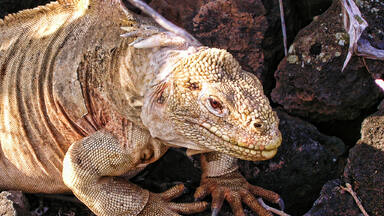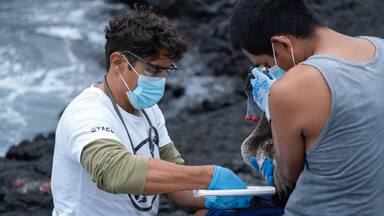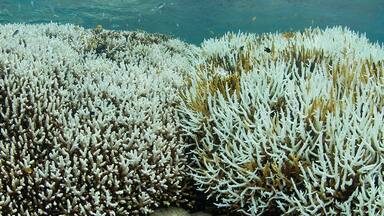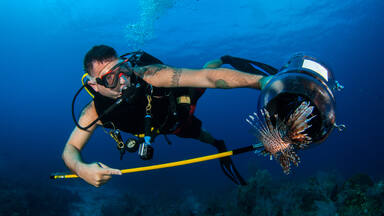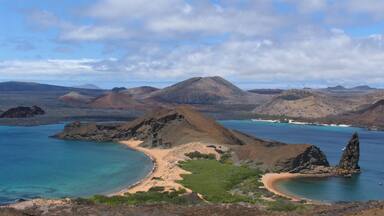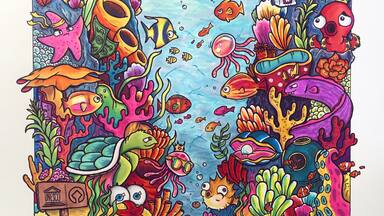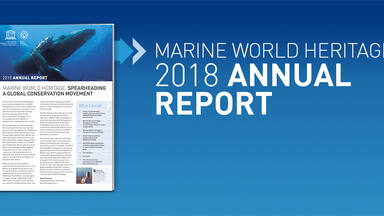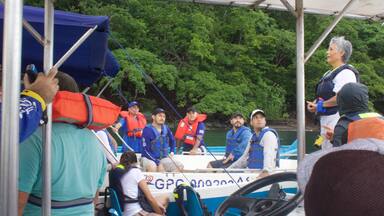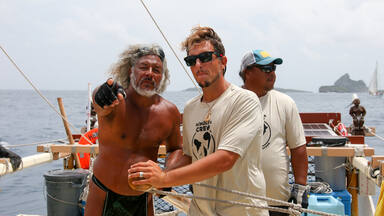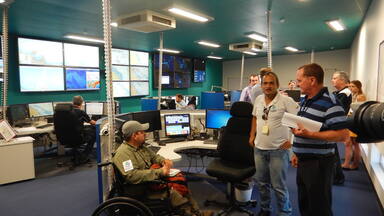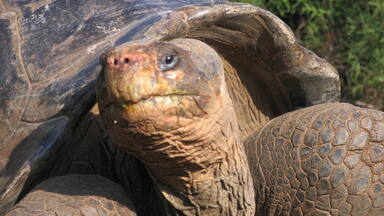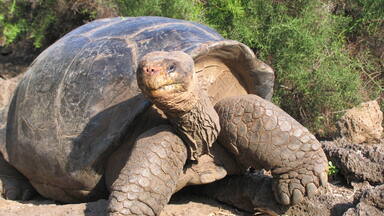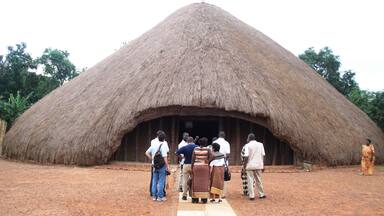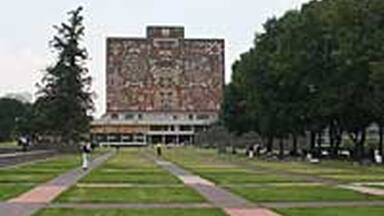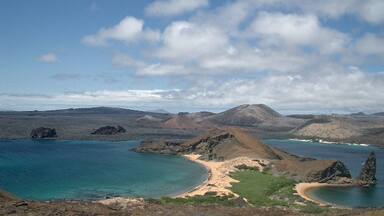Galápagos Islands
Galápagos Islands
Situated in the Pacific Ocean some 1,000 km from the South American continent, these 19 islands and the surrounding marine reserve have been called a unique ‘living museum and showcase of evolution’. Located at the confluence of three ocean currents, the Galápagos are a ‘melting pot’ of marine species. Ongoing seismic and volcanic activity reflects the processes that formed the islands. These processes, together with the extreme isolation of the islands, led to the development of unusual animal life – such as the land iguana, the giant tortoise and the many types of finch – that inspired Charles Darwin’s theory of evolution by natural selection following his visit in 1835.
Description is available under license CC-BY-SA IGO 3.0
Îles Galápagos
Situées dans l’océan Pacifique, à environ 1000 km du continent sud-américain, ces dix-neuf îles et la réserve marine qui les entoure constituent un musée et un laboratoire vivants de l’évolution uniques au monde. Au confluent de trois courants océaniques, les Galápagos sont un creuset d’espèces marines. L’activité sismique et le volcanisme toujours en activité illustrent les processus qui ont formé ces îles. Ces processus, ainsi que l’isolement extrême de ces îles, ont entraîné le développement d’une faune originale - notamment l’iguane terrestre, la tortue géante et de nombreuses espèces de pinsons qui inspira à Charles Darwin sa théorie de l’évolution par la sélection naturelle à la suite de sa visite en 1835.
Description is available under license CC-BY-SA IGO 3.0
أرخبيل جزر غالاباغوس
على مسافة 1000 كيلومتر من القارة الأمريكيّة الجنوبيّة، تقع الجزر التسعة عشر والمحميّة البحريّة التي تحيطها وتكوّن متحفاً ومختبراً حيّين فريدين من نوعهما في المحيط الهادئ. وعند نقطة تلاقي تيارات المحيطات الثلاثة، تشكّل غالاباغوس بوتقة الأصناف البحريّة. فحركة الزلازل والبراكين الثائرة تجسّد عمليّات تكوين هذه الجزر. ولقد أدّت هذه العمليّات، ناهيك عن انعزال هذه الجزر التام، إلى تطوّر ثروة حيوانيّة فريدة من نوعها وخصوصاً الإغوانة البريّة والسلحفاة العملاقة وأصناف عديدة من عصافير البرقش التي استوحى منها شارل داروين نظريّته الشهيرة بعد زيارته عام 1835.
source: UNESCO/CPE
Description is available under license CC-BY-SA IGO 3.0
加拉帕戈斯群岛
群岛地处离南美大陆1000公里的太平洋上,由19个火山岛以及周围的海域组成,被人称作独一无二的“活的生物进化博物馆和陈列室”。加拉帕戈斯群岛处于三大洋流的交汇处,是海洋生物的“大熔炉”。持续的地震和火山活动反映了群岛的形成过程。这些过程,加上群岛与世隔绝的地理位置,促使群岛内进化出许多奇异的动物物种,例如陆生鬣蜥、巨龟和多种类型的雀类。1835年查尔斯·达尔文参观了这片岛屿后,从中得到感悟,进而提出了著名的进化论。
source: UNESCO/CPE
Description is available under license CC-BY-SA IGO 3.0
Галапагосские острова
Архипелаг лежит в Тихом океане на расстоянии около 1 тыс. км от берегов Южной Америки. 19 островов этой группы, вместе с прилегающей акваторией, называют «живым музеем эволюции». Поскольку Галапагосы располагаются на пересечении трех океанических течений, они выступают в роли «плавильного котла» по отношению к обитателям морской среды. Здесь продолжается сейсмическая и вулканическая активность, что приводит к постоянному обновлению ландшафта. Эти процессы, наряду с большой изолированностью островов, привели к появлению таких оригинальных созданий как морская игуана, гигантская сухопутная черепаха, и многие разновидности вьюрков, наблюдения за которыми натолкнули Чарлза Дарвина после его визита сюда в 1835 г. на создание теории эволюции.
source: UNESCO/CPE
Description is available under license CC-BY-SA IGO 3.0
Islas Galápagos
Situadas en el Pacífico, a unos mil kilómetros del subcontinente sudamericano, estas diecinueve islas de origen volcánico y su reserva marina circundante son un museo y un laboratorio vivientes de la evolución, únicos en el mundo. Las Galápagos están situadas en la confluencia de tres corrientes oceánicas y concentran una gran variedad de especies marinas. Su actividad sísmica y volcánica ilustra los procesos de su formación geológica. Estos procesos, sumados al extremo aislamiento del archipiélago, han originado el desarrollo de una fauna singular con especies como la iguana terrestre, la tortuga gigante y numerosas especies de pinzones, cuyo estudio inspiró a Darwin la teoría de la evolución por selección natural, tras su viaje a estas islas en 1835.
source: UNESCO/CPE
Description is available under license CC-BY-SA IGO 3.0
ガラパゴス諸島
赤道直下の太平洋上に浮かぶエクアドル領の島々。多くの動植物が島で独自の進化を遂げたことから、「種の方舟(はこぶね)」と呼ばれている。しかし持ち込まれた移入動物、ゴミや水質汚染などによって、現在その生態系は危機を迎えている。1835年ダーウィンがビーグル号で来航し、『種の起源』を著すきっかけとなった島でもある。source: NFUAJ
Galápagos Eilanden
De Galápagos Eilanden liggen in de Stille Oceaan, zo’n 1.000 kilometer van het Zuid-Amerikaanse continent. Ze omvatten 19 eilanden, die samen met het omliggende zeereservaat een ‘levend museum en toonbeeld van evolutie’ worden genoemd. Voortdurende seismische en vulkanische processen hebben de eilanden gevormd. Deze processen en de extreme afzondering van de eilanden, hebben geleid tot de ontwikkelingen van ongebruikelijk dierlijk leven, zoals de landleguaan, de reuzenschildpad en vele soorten vinken. De Galápagos eilanden liggen op de plek waar drie oceaanstromingen samenkomen en het gebied bevat daarom ook een mix van marine soorten. Het gebied inspireerde Charles Darwin tot de ontwikkeling van de evolutietheorie, na zijn bezoek in 1835.
Source: unesco.nl
Outstanding Universal Value
Brief synthesis
The Galapagos Islands area situated in the Pacific Ocean some 1,000 km from the Ecuadorian coast. This archipelago and its immense marine reserve is known as the unique ‘living museum and showcase of evolution’. Its geographical location at the confluence of three ocean currents makes it one of the richest marine ecosystems in the world. Ongoing seismic and volcanic activity reflects the processes that formed the islands. These processes, together with the extreme isolation of the islands, led to the development of unusual plant and animal life – such as marine iguanas, flightless cormorants, giant tortoises, huge cacti, endemic trees and the many different subspecies of mockingbirds and finches – all of which inspired Charles Darwin’s theory of evolution by natural selection following his visit in 1835.
Criterion vii: The Galapagos Marine Reserve is an underwater wildlife spectacle with abundant life ranging from corals to sharks to penguins to marine mammals. No other site in the world can offer the experience of diving with such a diversity of marine life forms that are so familiar with human beings, that they accompany divers. The diversity of underwater geomorphological forms is an added value to the site producing a unique display, which cannot be found anywhere else in the world.
Criterion viii: The archipelago´s geology begins at the sea floor and emerges above sea level where biological processes continue.. Three major tectonic plates—Nazca, Cocos and Pacific— meet at the basis of the ocean, which is of significant geological interest. In comparison with most oceanic archipelagos, the Galapagos are very young with the largest and youngest islands, Isabela and Fernandina, with less than one million years of existence, and the oldest islands, Española and San Cristóbal, somewhere between three to five million years. The site demonstrates the evolution of the younger volcanic areas in the west and the older islands in the east. On-going geological and geomorphological processes, including recent volcanic eruptions, small seismic movements, and erosion provide key insights to the puzzle of the origin of the Galapagos Islands. Almost no other site in the world offers protection of such a complete continuum of geological and geomorphological features.
Criterion ix: The origin of the flora and fauna of the Galapagos has been of great interest to people ever since the publication of the “Voyage of the Beagle” by Charles Darwin in 1839. The islands constitute an almost unique example of how ecological, evolutionary and biogeographic processes influence the flora and fauna on both specific islands as well as the entire archipelago. Darwin’s finches, mockingbirds, land snails, giant tortoises and a number of plant and insect groups represent some of the best examples of adaptive radiation which still continues today. Likewise, the Marine Reserve, situated at the confluence of 3 major eastern Pacific currents and influenced by climatic phenomena such as El Niño, has had major evolutionary consequences and provides important clues about species evolution under changing conditions. The direct dependence on the sea for much of the island’s wildlife (e.g. seabirds, marine iguanas, sea lions) is abundantly evident and provides an inseparable link between the terrestrial and marine worlds.
Criterion x: The islands have relatively high species diversity for such young oceanic islands, and contain emblematic taxa such as giant tortoises and land iguanas, the most northerly species of penguin in the world, flightless cormorants as well as the historically important Darwin’s finches and Galapagos mockingbirds. Endemic flora such as the giant daisy trees Scalesia spp. and many other genera have also radiated on the islands, part of a native flora including about 500 vascular plant species of which about 180 are endemic. Examples of endemic and threatened species include 12 native terrestrial mammal species (11 endemic, with 10 threatened or extinct) and 36 reptile species (all endemic and most considered threatened or extinct), including the only marine iguana in the world. Likewise the marine fauna has an unusually high level of diversity and endemism, with 2,909 marine species identified with 18.2% endemism. High profile marine species include sharks, whale sharks, rays and cetaceans. The interactions between the marine and terrestrial biotas (e.g. sea lions, marine and terrestrial iguanas, and seabirds) are also exceptional. Recent exploration of deep sea communities continues to produce new additions to science.
Integrity
The Galapagos archipelago is located about 1,000 km from continental Ecuador and is composed of 127 islands, islets and rocks, of which 19 are large and 4are inhabited. 97% of the total emerged surface (7,665,100 ha) was declared National Park in 1959. Human settlements are restricted to the remaining 3% in specifically zoned rural and urban areas on four islands (a fifth island only has an airport, tourism dock, fuel containment, and military facilities). The islands are surrounded by the Galapagos Marine Reserve which was created in 1986 (70,000 km2) and extended to its current area (133,000 km2) in 1998, making it one of the largest marine reserves in the world. The marine reserve includes inland waters of the archipelago (50,100 km2) in addition to all those contained within 40 nautical miles, measured from the outermost coastal islands. Airports on two islands (Baltra and San Cristobal) receive traffic from continental Ecuador with another airport on Isabela mostly limited to inter-island traffic. All the inhabited islands have ports to receive merchandise. The other uninhabited islands are strictly controlled with carefully planned tourist itineraries limiting visitation. Around 30,000 people live on the islands, and approximately 170,000 tourists visit the islands each year.
Protection and management requirements
The main threats to the Galapagos are the introduction of invasive species, increased tourism, demographic growth, illegal fishing and governance issues (i.e. who takes responsibility for decisions given the large number of stakeholders with conflicting interests involved in managing the islands). These issues are constantly analyzed and monitored to adequately manage them and reinforce strategies to minimize their impact.
In 1986 a law was passed to control fishing and over-exploitation of Galapagos marine resources. Protection was further strengthened by the “Special Regime Law for the Conservation and Sustainable Development in the Province of the Galapagos” of 1998, and inscribed in the Constitution of the Republic of Ecuador. This law designated the current Galapagos Marine Reserve as a protected area under the responsibility of the Galapagos National Park Service. Among other issues, it provides the specific legal framework over which many aspects of island life are to be regulated, including provincial planning; inspection and quarantine measures; fisheries management; control and marine monitoring; residency and migration of people to the islands; tourism through a visitor management system, permits and quotas; agriculture; waste management; and “total control” of introduced species. This management imposes some limitations on the exercise of the rights of people living in this geographical area, but also provides them with preferential rights to use the natural resources sustainably. Within this framework the Galapagos National Park Service has periodically prepared Management Plans since 1974 to date, which have been developed in a participatory manner among the different social and economic groups through community representatives and local authorities to address the changing realities of the Galapagos ecosystem. This includes tools for development and conservation management of natural resources in harmony with international standards. For example, a zoning system has been implemented to establish areas of sustainable use and areas prohibited to the local population. Governmental institutions contribute to the funding of conservation and management in the archipelago. Other support comes from the entry fee paid by tourists and a small percentage from international donations.
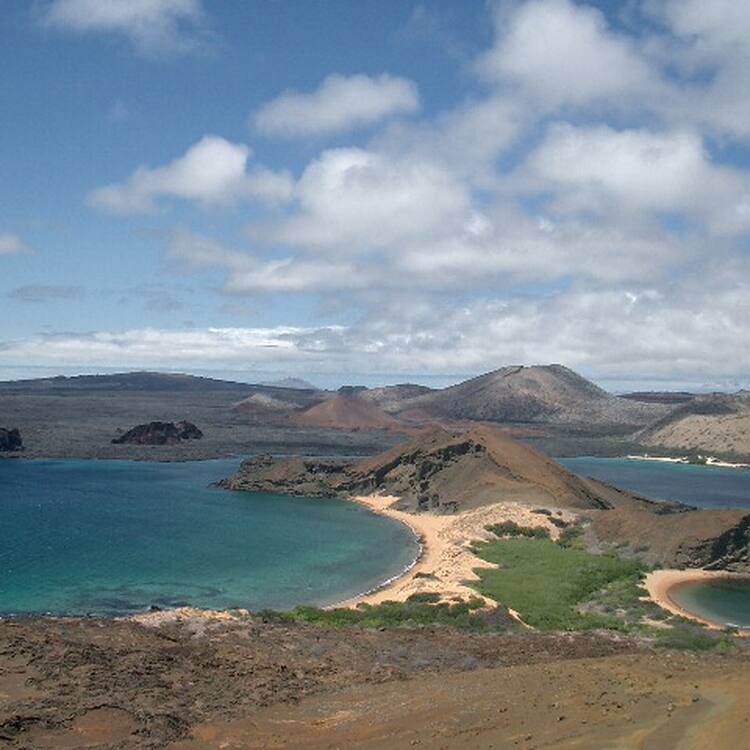
 View photos from OUR PLACE the World Heritage collection
View photos from OUR PLACE the World Heritage collection

